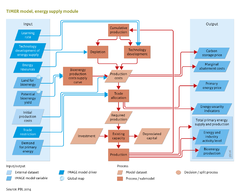Energy supply/Description: Difference between revisions
Jump to navigation
Jump to search
Edelenbosco (talk | contribs) No edit summary |
Oostenrijr (talk | contribs) m (Text replacement - "et al. 2" to "et al., 2") |
||
| Line 68: | Line 68: | ||
<div class="version newv31"> | <div class="version newv31"> | ||
Besides the energy crops mentioned above, agricultural and forestry residues can also be used as a primary feedstock for modern bioenergy. The availability of residues is linked to the productivity of agriculture and forestry, taking into account the effect of changing yields (see [[Agricultural economy/Description|Agricultural economy]] description) or [[Forest management]] techniques. The available potential is limited by environmental constraints as well as competing uses (use of agricultural residues as feed for livestock, see [[Agricultural economy/Description|Agricultural economy]]). As with bioenergy crops, availability and costs of residues are calculated on a 0.5x0.5 degree grid. For further details see ([[Daioglou et al. 2016]]). | Besides the energy crops mentioned above, agricultural and forestry residues can also be used as a primary feedstock for modern bioenergy. The availability of residues is linked to the productivity of agriculture and forestry, taking into account the effect of changing yields (see [[Agricultural economy/Description|Agricultural economy]] description) or [[Forest management]] techniques. The available potential is limited by environmental constraints as well as competing uses (use of agricultural residues as feed for livestock, see [[Agricultural economy/Description|Agricultural economy]]). As with bioenergy crops, availability and costs of residues are calculated on a 0.5x0.5 degree grid. For further details see ([[Daioglou et al., 2016]]). | ||
</div> | </div> | ||
Revision as of 14:44, 20 June 2017
Parts of Energy supply/Description
| Component is implemented in: |
|
| Related IMAGE components |
| Projects/Applications |
| Key publications |
| References |
